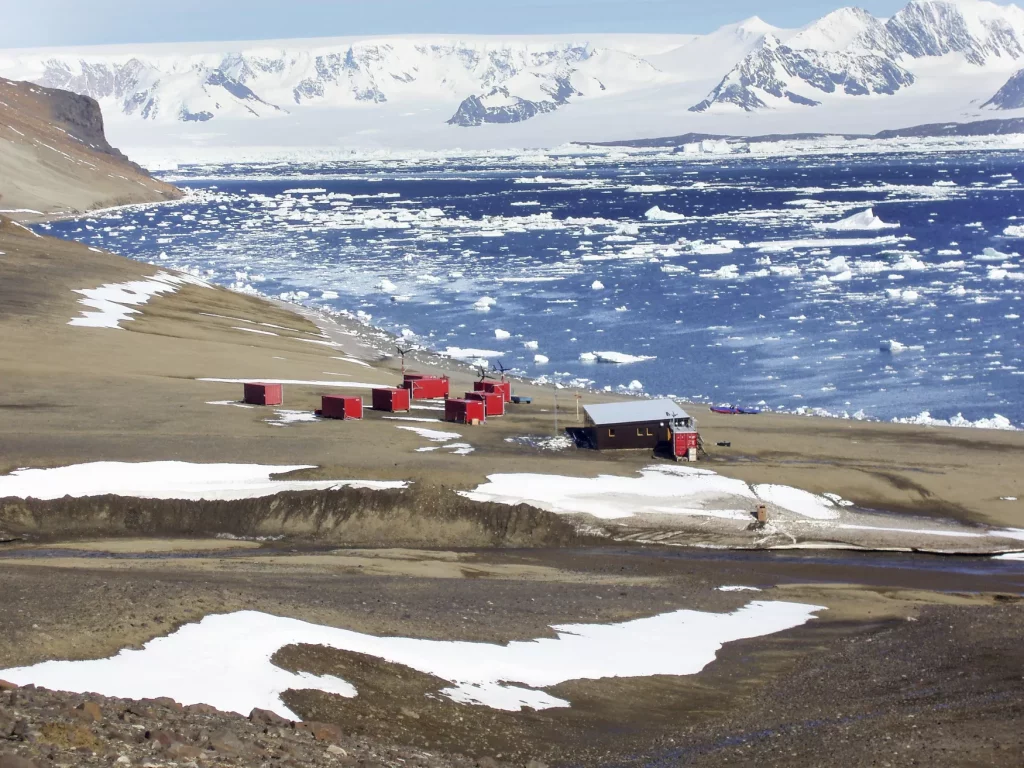In the southernmost part of the earth, a mysterious and challenging continent – Antarctica, with its unique geographical location, extreme climate conditions and rich scientific value, has attracted the attention of scientists around the world. The Antarctic Peninsula, as an important part of Antarctica, is a hot spot for scientists to carry out scientific research activities. This paper will deeply discuss the design, construction and operation of the Antarctic Peninsula research station, analyze its important role in Antarctic research, discuss the challenges and difficulties faced, and finally put forward prospects and suggestions for future scientific research activities.
Geographical location, climatic characteristics and historical background of the Antarctic Peninsula
Located in West Antarctica, the Antarctic Peninsula is the continent’s largest and most northerly large peninsula extending into the ocean. It is bordered by the Weddell Sea and Bellingshausen Sea to the east and west, with a broad continental shelf offshore and Filchner marginal ice to the east. The Drake Passage, 970 kilometers to the north, borders South America with rugged mountains and icy plateaus. Due to its unique geographical location, the Antarctic Peninsula has become an important channel connecting the Antarctic interior with the South Atlantic Ocean, and has also become an important base for scientists to carry out Antarctic research.
The climate of the Antarctic Peninsula can be described as “cold, dry, gale”. Due to its high latitude, the Antarctic Peninsula receives less solar radiation and has extremely low temperatures. At the same time, due to the strong reflection of solar radiation by snow and ice, the Antarctic Peninsula is even colder. In addition, the Antarctic Peninsula is controlled by the polar high pressure belt throughout the year, with little precipitation and strong winds, making it one of the windiest and stormiest regions in the world.
The historical background of the Antarctic Peninsula is rich and complex. First discovered by explorers in 1820, the Antarctic Peninsula has captivated countless explorers and scientists. The United Kingdom, Argentina, Chile and other countries have made territorial claims to it. Until 1961, when the Antarctic Treaty froze all claims to Antarctic territory, the Antarctic Peninsula became a common area of global scientific research.

Design, construction and operation of the scientific research station
As the important infrastructure of Antarctic scientific research activities, the design, construction and operation of Antarctic research stations are facing great challenges. First, in terms of location, the research station needs to be located in an area that is convenient for scientific research, material transportation and personnel safety. Secondly, in terms of design and construction, scientific research stations need to be able to withstand extreme climatic conditions and geological environments, while meeting the needs of scientific research, life and safety.
A research station on the Antarctic Peninsula, for example, uses an advanced modular design that allows the entire station to be quickly set up and dismantled in a short period of time. At the same time, the scientific research station is also equipped with advanced scientific research equipment, living facilities and communication equipment to meet the needs of researchers’ work and life. In terms of operation, the scientific research station implements a strict management system to ensure the smooth progress of scientific research activities and the safety of personnel.
The main functions of the station include meteorological observation, glacier monitoring, biological ecological research, geological exploration and many other aspects. Through the data and samples collected by the research stations, researchers can gain an in-depth understanding of the Antarctic Peninsula’s climate change, glacier dynamics, biodiversity and other scientific issues, providing important support for global climate change, ecological protection and other fields of research.
The important role of scientific research stations in scientific research on the Antarctic Peninsula
The station plays a vital role in scientific research on the Antarctic Peninsula. First of all, scientific research stations are important bases for researchers to carry out scientific research. Through the data and samples collected by the scientific research station, researchers can conduct in-depth research on climate change, glacier dynamics, biodiversity and other scientific issues on the Antarctic Peninsula, providing important support for research in the fields of global climate change and ecological protection.
Secondly, research stations are important hubs for navigation and communication. In an extreme environment such as the Antarctic Peninsula, navigation and communication are crucial to the smooth running of scientific activities. Scientific research stations equipped with advanced navigation and communication equipment can provide accurate navigation and communication support for scientific research activities to ensure the smooth progress of scientific research activities.
In addition, the scientific research station is also an important base for material supply and personnel security. In such an extreme environment as the Antarctic Peninsula, the supply of materials and personnel is an important guarantee for the smooth conduct of scientific research activities. Scientific research station by equipped with advanced materials storage and transportation equipment, as well as perfect personnel support system, can provide sufficient materials and personnel support for scientific research activities.

Challenges and difficulties faced by scientific research stations and solutions
Although the station plays an important role in the Antarctic Peninsula research, it also faces many challenges and difficulties. First of all, the extreme weather conditions on the Antarctic Peninsula have brought great challenges to the construction and operation of scientific research stations. In order to meet this challenge, researchers need to use advanced building materials and construction techniques to ensure that the research station can remain stable and safe in extreme climatic conditions.
Secondly, the geological environment of the Antarctic Peninsula is complex and changeable, which brings many uncertainties to the construction and operation of scientific research stations. In order to meet this challenge, researchers need to fully consider geological factors in the site selection and design phase to ensure the safe and reliable construction and operation of research stations.
In addition, the Antarctic Peninsula is also facing many difficulties in the supply of materials and personnel. Because the Antarctic Peninsula is far from human settlements, supplies and personnel need to rely on external support. In order to cope with this challenge, researchers need to establish a sound material supply and personnel security system to ensure the smooth progress of scientific research activities.
To address the above challenges and difficulties, researchers can adopt the following solutions: First, strengthen international cooperation to jointly cope with the challenges and difficulties in Antarctic scientific research; Second, strengthen scientific and technological innovation to improve the construction and operation efficiency of scientific research stations; The third is to strengthen personnel training and team construction, improve the quality and ability of scientific research personnel.
Summary and outlook
The research station on the Antarctic Peninsula is the important infrastructure of the Antarctic research activities, and it plays a vital role in the Antarctic research. Through the in-depth discussion of the design, construction and operation of the Antarctic Peninsula research station, we can understand the importance and role of the station in the Antarctic research more comprehensively. At the same time, we should also see the challenges and difficulties faced by scientific research stations in the Antarctic, and adopt corresponding solutions to deal with these challenges and difficulties.
Looking forward to the future, with the global climate change and the increasingly severe ecological protection, Antarctic scientific research activities will become more and more important. We should strengthen international cooperation and scientific and technological innovation, improve the construction and operation efficiency of scientific research stations, and provide more solid and powerful support for scientific research activities in Antarctica. At the same time, we should also strengthen the protection and management of the Antarctic environment to ensure the stability and sustainable development of the Antarctic ecosystem.





















